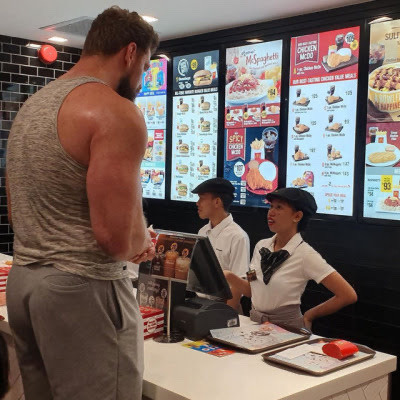ADDITIONAL REFERENCES
I feel stupid for asking this so im using anon, but how do you draw the hijab? Whenever I try it looks like an egg www
also, Ramadan Mubarak! May Allah bless you
Don’t feel stupid for asking! Drawing is hard no matter what you’re drawing, so don’t be afraid to ask for help^^ But honestly even I feel like the best of my hijabis look a little egg-like, and that’s okay!











This tutorial is already taking so goddamn long, so I’m just gonna link my coloring and shading tutorial I did a month ago 😭😭

Gosh, I hope what I wrote made sense 😅 But thank you so much for the well wishes! Happy Ramadan (Eid Mubarak at this point WAHHH), and the same to you, may you and your loved ones have many blessings!!
ADDITIONAL REFERENCES
Winchester Meg's Hijab Drawing Tutorial
Souratgar's Hijab Drawing Tutorial
General Tips for Drawing and Shading Fabrics
More Posts from Basket-of-references and Others







Very happy to finally post my second tutorial ! You guys have been so kind the last time and I really hope this helps some of you in your art path 🙇♀️
Hello! I hope you dont mind me asking, but how do you draw those amazing black and white comics? (Coffee and The Goddess comics come to mind!) I love the way you do them and would love to know the process you go thru!
this is a pretty broad question and im guessing/hoping you meant “how do you color in black and white in your comics” so have a few random tips about values and paneling and stuff i guess







thank you
U use colors in such a enrichening way, how do you do that may I ask??
thank you so much! 💕
this answer is going to be a little long.
the first thing, i think, is that it's very common to think of color as a means to an end, as just another type of information about a drawing: i'm using brown on the hair to show that the hair is brown, i'm using green to show that the characters are standing in grass.
but if color is information, then we can use it to say a lot more than just the basic facts of a drawing!
if you love drawing but want to get better with color, you have to learn to love color, too.
to want to know everything about how color works, to explore what different colors mean to you, to try and try and try again.
because, and this is the kicker:
ALL COLORS ARE RELATED TO EACH OTHER!

[from this post about how to use a color wheel]
i think it's common for people to talk about complementary colors and that's helpful when you're starting out with coloring, but i feel that it can become very limiting when it's treated like a rule and can obscure the fact that all colors are related to each other. it's called a color wheel because there is no beginning or end!

for example, take this drawing:

in this drawing, i'm using colors from all over:

but by just rearranging them slightly and throwing them against a black background like in the drawing, you can see how they're actually relating to each other and not nearly as random as they may seem at first glance!

[these notes are from this post where i break down how muted or "ugly" colors pull an image together] all colors are related to each other in some way, and that means that
YOU MUST DETERMINE WHAT EACH COLOR MEANS TO YOU, AND IT IS YOUR RESPONSIBILITY TO CONVEY THAT MEANING TO YOUR AUDIENCE.

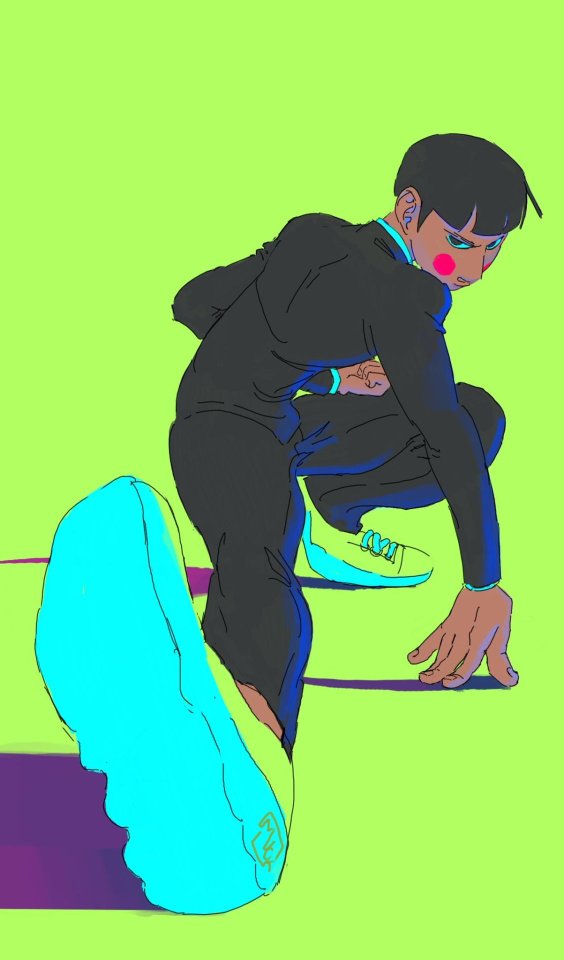

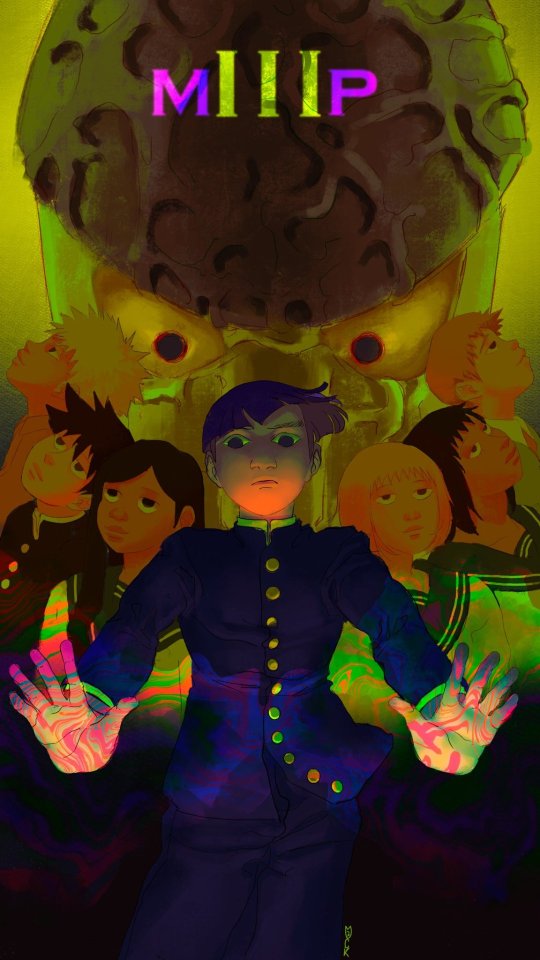
for example, to me green can be uncomfortable and overwhelming, energetic and edgy, calm and natural, or fearful and tense. but no matter how it makes me feel, it's my responsibility to convey my relationship to green to whoever even glances at my drawing.
sure you can use commonly held ideas about colors [red = angry, blue = sad], but this shorthand is also limiting. if everyone used these commonly held ideas about color, there would be no room for experimentation or interesting, wild color choices! and colors mean different things to everyone-- that's what makes everyone's colorful art so different and so cool!!
another thing to note about those green drawings: each one is using a specific type of green.
the one with reigen leans blue-green, which creates a cool-colored image. meanwhile, reigen is warmer tones, which almost makes it seem like he's overheating when he's thrown against such a cool-toned background, which further expresses his discomfort!
the dimple!mob drawing is like a sprite or mountain dew-green, which encourages the feeling of electricity or energy. it's a cool yellowish-green.
the one of mob floating is a warmer yellowish-green, to suggest sunny warmth without drawing sun rays.
the divine tree arc drawing is a lot of reddish-greens, which can suggest a sickliness.
experiment with color combinations and different shades and hues! explore what these different types of colors mean to you!
so now let's get into the nitty gritty of color choice. the following images are from my free pdf about color, composition, and intuitive drawing:






the main takeaways from these pages are:
consider simplifying your colors! more colors does not necessarily equal a better drawing.
see how much a single color can do! can you use it in multiple places on your drawing? what meaning can you ascribe to the colors you're using?
consider creating a concept for your colors and a few rules to guide your piece! a lot of great drawings can fall apart because the coloring concept was too vague or because there weren't enough rules or guidelines to keep the image coherent.
are your colors saturated enough? are the different colors you're using fighting for the viewer's attention? do you have focal points in your art, and if so, are the colors you're using reinforcing those focal points?
use the tools at your disposal! color-picking, color balance, overlay layers. it can feel important to try to prove something by hand-picking every color, but even when i hand-pick my colors i almost always check them with color balance anyway to make sure i'm picking the best colors possible.
YOU DO NOT HAVE TO SUFFER FOR ART. PLEASE use everything that is available to you, and make sure that you are aligned with what brings you joy when you're making art!
i wanted to show an example of a drawing i've done that is doing way too much vs a drawing that is simpler but more balanced:


on the left, the colors are interesting but the background is too strong and is competing with the actual drawing for attention. on the right, the clear background and simple coloring create a cute, easy to read, successful image! this is what i mean when i say that colors can fight for the viewer's attention and mess up a good drawing.
my final secret is that i rarely shade with or use white, black, or grays. i don't think this is a rule that you have to follow, but i like it because it pushes me to figure out what colors will go best with each other, and i think this single tip has strengthened my understanding of color immensely. however, there are a lot of beautiful art styles that shade with and use pure white, black, and gray. you have to decide what you love!
and
STUDY!!!
look at other people's art, color pick it, and make a palette based on their art! look at how they represent values through color, how they shade, etc. study your favorite artists' work!! you will learn so much!!
i hope this was helpful! if you have any more follow-up questions or if there's something that you want to know that i didn't explain here, please don't hesitate to ask!
received a few asks about how i draw tf characters and so finally i sat down and started scratching out some notes :))
i'll add more later on if more people are interested and when i have some time,, but i hope these are somewhat informative ?? of at least my own thought processes when it comes to drawing the robot guys




Art Help

I redid this list because broken links 💀
General Tips
Stretch your fingers and hands
Art is for fun
Never too late to start/improve
Using a tablet
Editing software: pictures & video
Moodboard resources
Comic pacing
Watercolor
Coloring
Color Theory (not children's hospital)
Resources: coloring things a different color
Gold
Dark Skin undertones
Dark Skin in pastel art
POC Blush tones
Eyes colors
Human Anatomy
POSE REFERENCES
Wizard Battle poses
Shoulders
Tips for practicing anatomy
Proportional Limbs
Skeletons
Hair Directions
Afro, 4C hair
Clothing
Long skirts
Traditional Chinese Hanfu (clothing reference)
CLOTHING REFERENCE
Sewing information
Animals
Horse -> Dragon
Snouts: dogs, cats, wolves, fox
Foot, paw, hoof
More
Drawing references sources
Art tutorial Masterlist
Another art tutorial Masterlist
Inspiration: father recreates son's art
Inspiration: Lights
ART BOOKS
Plants/flowers: North America, Hawaii, Patagonia









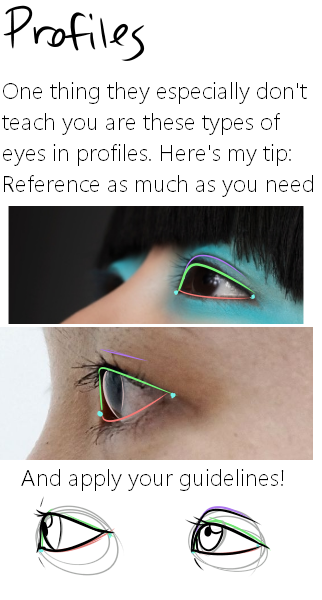
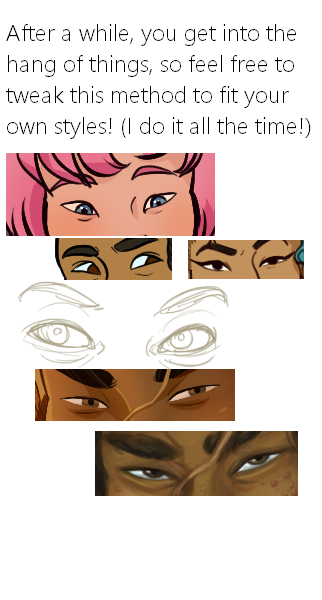
Here it is, my long winded tutorial, complete with some step by step action. I see a lot of people talk about wanting to diversify their artwork but not knowing how. This is my help to you. You really should take the time to invest in learning diverse eye shapes as diverse artwork always makes you a better artist. And frankly I’m really tired of drawing tutorials that talk up character diversity but only have the stereotypical “one Asian eye”.
I did some step by steps for those three diagrams, but I actually got them from this blog which has 14 of those examples! (Bonus: it’s a makeup blog so if you need help with that or want some idea of how to shade these eyes, there ya go)
art cheats
hello i am here today to not lose track of the art cheats i have discovered over the years. what i call art cheat is actually a cool filter/coloring style/way to shade/etc. that singlehandedly makes art like 20 times better
80’s anime style
glitch effect
glow effects
adding colors to grayscale paintings
foreshortening ( coil )
foreshortening ( perspective )
clipping group (lines)
clipping group (colors)
dramatic lighting ( GOOD )
shading metal
lighting faces
that is all for today, do stay tuned as i am always hunting for cool shit like this
Other Words for "Look" + With meanings | List for writers
Many people create lists of synonyms for the word 'said,' but what about the word 'look'? Here are some synonyms that I enjoy using in my writing, along with their meanings for your reference. While all these words relate to 'look,' they each carry distinct meanings and nuances, so I thought it would be helpful to provide meanings for each one.
Gaze - To look steadily and intently, especially in admiration or thought.
Glance - A brief or hurried look.
Peek - A quick and typically secretive look.
Peer - To look with difficulty or concentration.
Scan - To look over quickly but thoroughly.
Observe - To watch carefully and attentively.
Inspect - To look at closely in order to assess condition or quality.
Stare - To look fixedly or vacantly at someone or something.
Glimpse - To see or perceive briefly or partially.
Eye - To look or stare at intently.
Peruse - To read or examine something with great care.
Scrutinize - To examine or inspect closely and thoroughly.
Behold - To see or observe a thing or person, especially a remarkable one.
Witness - To see something happen, typically a significant event.
Spot - To see, notice, or recognize someone or something.
Contemplate - To look thoughtfully for a long time at.
Sight - To suddenly or unexpectedly see something or someone.
Ogle - To stare at in a lecherous manner.
Leer - To look or gaze in an unpleasant, malicious way.
Gawk - To stare openly and stupidly.
Gape - To stare with one's mouth open wide, in amazement.
Squint - To look with eyes partially closed.
Regard - To consider or think of in a specified way.
Admire - To regard with pleasure, wonder, and approval.
Skim - To look through quickly to gain superficial knowledge.
Reconnoiter - To make a military observation of a region.
Flick - To look or move the eyes quickly.
Rake - To look through something rapidly and unsystematically.
Glare - To look angrily or fiercely.
Peep - To look quickly and secretly through an opening.
Focus - To concentrate one's visual effort on.
Discover - To find or realize something not clear before.
Spot-check - To examine something briefly or at random.
Devour - To look over with eager enthusiasm.
Examine - To inspect in detail to determine condition.
Feast one's eyes - To look at something with great enjoyment.
Catch sight of - To suddenly or unexpectedly see.
Clap eyes on - To suddenly see someone or something.
Set eyes on - To look at, especially for the first time.
Take a dekko - Colloquial for taking a look.
Leer at - To look or gaze in a suggestive manner.
Rubberneck - To stare at something in a foolish way.
Make out - To manage to see or read with difficulty.
Lay eyes on - To see or look at.
Pore over - To look at or read something intently.
Ogle at - To look at in a lecherous or predatory way.
Pry - To look or inquire into something in a determined manner.
Dart - To look quickly or furtively.
Drink in - To look at with great enjoyment or fascination.
Bask in - To look at or enjoy something for a period of time.


-
 wander-over-the-words reblogged this · 2 weeks ago
wander-over-the-words reblogged this · 2 weeks ago -
 shizukamoon reblogged this · 2 weeks ago
shizukamoon reblogged this · 2 weeks ago -
 shizukamoon liked this · 2 weeks ago
shizukamoon liked this · 2 weeks ago -
 gayfaepup reblogged this · 3 weeks ago
gayfaepup reblogged this · 3 weeks ago -
 gayfaepup liked this · 3 weeks ago
gayfaepup liked this · 3 weeks ago -
 umbelina-e-helena-na-luz reblogged this · 3 weeks ago
umbelina-e-helena-na-luz reblogged this · 3 weeks ago -
 t0omanythoughts reblogged this · 3 weeks ago
t0omanythoughts reblogged this · 3 weeks ago -
 transgressivebeast liked this · 3 weeks ago
transgressivebeast liked this · 3 weeks ago -
 baylabi liked this · 3 weeks ago
baylabi liked this · 3 weeks ago -
 philipsrainyday liked this · 3 weeks ago
philipsrainyday liked this · 3 weeks ago -
 yesmanforever liked this · 3 weeks ago
yesmanforever liked this · 3 weeks ago -
 angrymadsygin liked this · 3 weeks ago
angrymadsygin liked this · 3 weeks ago -
 arkinnameless-blog liked this · 3 weeks ago
arkinnameless-blog liked this · 3 weeks ago -
 tori-artemis reblogged this · 3 weeks ago
tori-artemis reblogged this · 3 weeks ago -
 tori-artemis liked this · 3 weeks ago
tori-artemis liked this · 3 weeks ago -
 thecryptidenthusiast liked this · 3 weeks ago
thecryptidenthusiast liked this · 3 weeks ago -
 d34th0rl0v3t0n1t3 liked this · 3 weeks ago
d34th0rl0v3t0n1t3 liked this · 3 weeks ago -
 symphonic-concert reblogged this · 3 weeks ago
symphonic-concert reblogged this · 3 weeks ago -
 purplish-ocelot liked this · 3 weeks ago
purplish-ocelot liked this · 3 weeks ago -
 xaliaver reblogged this · 3 weeks ago
xaliaver reblogged this · 3 weeks ago -
 irregularnotagoblin liked this · 3 weeks ago
irregularnotagoblin liked this · 3 weeks ago -
 elegantartisanperson liked this · 3 weeks ago
elegantartisanperson liked this · 3 weeks ago -
 bluestonebliss reblogged this · 3 weeks ago
bluestonebliss reblogged this · 3 weeks ago -
 torment-deviser reblogged this · 3 weeks ago
torment-deviser reblogged this · 3 weeks ago -
 araelinn liked this · 3 weeks ago
araelinn liked this · 3 weeks ago -
 northstarlh reblogged this · 3 weeks ago
northstarlh reblogged this · 3 weeks ago -
 auroragehenna liked this · 3 weeks ago
auroragehenna liked this · 3 weeks ago -
 vins-paranoia liked this · 3 weeks ago
vins-paranoia liked this · 3 weeks ago -
 alcal2003 liked this · 3 weeks ago
alcal2003 liked this · 3 weeks ago -
 dearreaders-things reblogged this · 3 weeks ago
dearreaders-things reblogged this · 3 weeks ago -
 quinesone liked this · 3 weeks ago
quinesone liked this · 3 weeks ago -
 stunningtoredorsweetheart liked this · 3 weeks ago
stunningtoredorsweetheart liked this · 3 weeks ago -
 existential-dread-in-the-am liked this · 3 weeks ago
existential-dread-in-the-am liked this · 3 weeks ago -
 mr13andhiscalamities liked this · 3 weeks ago
mr13andhiscalamities liked this · 3 weeks ago -
 swashfullstop reblogged this · 3 weeks ago
swashfullstop reblogged this · 3 weeks ago -
 swashfullstop liked this · 3 weeks ago
swashfullstop liked this · 3 weeks ago -
 crochetandloki liked this · 3 weeks ago
crochetandloki liked this · 3 weeks ago -
 tittysuckersworld reblogged this · 3 weeks ago
tittysuckersworld reblogged this · 3 weeks ago -
 tittysuckersworld reblogged this · 3 weeks ago
tittysuckersworld reblogged this · 3 weeks ago -
 doctorsoul29 liked this · 3 weeks ago
doctorsoul29 liked this · 3 weeks ago -
 tittysuckersworld liked this · 3 weeks ago
tittysuckersworld liked this · 3 weeks ago -
 jaxofthevoid liked this · 3 weeks ago
jaxofthevoid liked this · 3 weeks ago -
 chillspacedragon liked this · 3 weeks ago
chillspacedragon liked this · 3 weeks ago -
 issacwild liked this · 3 weeks ago
issacwild liked this · 3 weeks ago -
 eyeoftheaxolotl reblogged this · 3 weeks ago
eyeoftheaxolotl reblogged this · 3 weeks ago -
 galaxythreads reblogged this · 3 weeks ago
galaxythreads reblogged this · 3 weeks ago -
 galaxythreads liked this · 3 weeks ago
galaxythreads liked this · 3 weeks ago -
 mettywiththenotes reblogged this · 3 weeks ago
mettywiththenotes reblogged this · 3 weeks ago






















